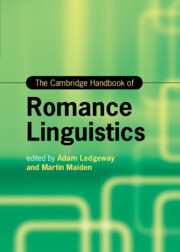Book contents
- The Cambridge Handbook of Romance Linguistics
- Cambridge Handbooks in Language and Linguistics
- The Cambridge Handbook of Romance Linguistics
- Copyright page
- Dedication
- Contents
- Figures
- Tables
- Contributors
- Abbreviations
- 1 Data, Theory, and Explanation: The View from Romance
- Part One What Is a Language?
- Part Two Phonetics and Phonology
- Part Three Morphology
- 10 Phonological and Morphological Conditioning
- 11 The Autonomy of Morphology
- 12 Suppletion
- 13 Inflexion, Derivation, Compounding
- 14 Evaluative Suffixes
- 15 Counting Systems
- Part Four Syntax
- Part Five Semantics and Pragmatics
- Part Six Language, Society, and the Individual
- Index
- References
14 - Evaluative Suffixes
from Part Three - Morphology
Published online by Cambridge University Press: 23 June 2022
- The Cambridge Handbook of Romance Linguistics
- Cambridge Handbooks in Language and Linguistics
- The Cambridge Handbook of Romance Linguistics
- Copyright page
- Dedication
- Contents
- Figures
- Tables
- Contributors
- Abbreviations
- 1 Data, Theory, and Explanation: The View from Romance
- Part One What Is a Language?
- Part Two Phonetics and Phonology
- Part Three Morphology
- 10 Phonological and Morphological Conditioning
- 11 The Autonomy of Morphology
- 12 Suppletion
- 13 Inflexion, Derivation, Compounding
- 14 Evaluative Suffixes
- 15 Counting Systems
- Part Four Syntax
- Part Five Semantics and Pragmatics
- Part Six Language, Society, and the Individual
- Index
- References
Summary
This chapter presents Romance evaluative suffixation not as a cabinet of curiosities but as a set of linguistic data with potentially important consequences for linguistic theorizing. The impact on linguistic theorizing that one is prepared to grant to these data depends on whether Romance evaluative suffixation is considered plain or expressive morphology. In the first part of the chapter, we conclude that it has greater affinities with the latter and counterexamples against supposed linguistic universals drawn from Romance evaluative morphology therefore should not be overrated. In the second part, an account of the semantic and pragmatic meaning of evaluative suffixation in the framework of Potts’s two-tiered semantics is shown to predict some of the seemingly abnormal behaviour of evaluative suffixes, such as their iterability when used in pragmatic function. In the third part, we present data from child-directed speech and dialects from Romania to Brazil that show evaluative suffixation outside verbal inflexion. This order of affixes is problematic for some theories that postulate a strict order of components in grammar, but we argue that it complies with deep principles underlying affix order in natural languages if one takes into account the peculiar affective-pragmatic use of diminutives as ‘sentence diminutives’ in some Romance varieties.
Keywords
- Type
- Chapter
- Information
- The Cambridge Handbook of Romance Linguistics , pp. 434 - 458Publisher: Cambridge University PressPrint publication year: 2022



